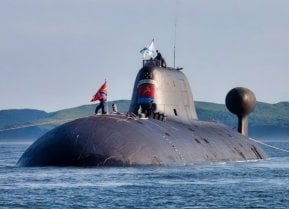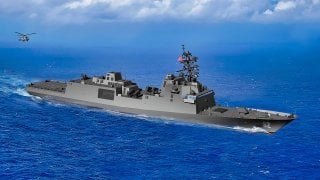The U.S. Navy's Constellation-Class Frigate Nightmare Is Real
The delays in the development and delivery of the Constellation-class frigate, alongside broader challenges within America's defense industrial base, highlight significant vulnerabilities as global tensions rise.
Summary: The delays in the development and delivery of the Constellation-class frigate, alongside broader challenges within America's defense industrial base, highlight significant vulnerabilities as global tensions rise.
-Originally slated for delivery by 2026, the new warship is now not expected until possibly 2029. This setback is part of a larger pattern of delays that also affects other critical naval assets like submarines.
-Such delays occur at a time when the geopolitical landscape is increasingly precarious, particularly with respect to China's advancements in anti-access/area denial (A2/AD) capabilities, which pose a strategic challenge to traditional U.S. naval operations in the Indo-Pacific.
Challenges Facing the U.S. Navy's Constellation-Class Frigate Amid Rising Global Tensions
The United States Navy has wanted a new frigate for some time. It settled on the Constellation-class, which has been billed as the most advanced frigate ever designed. Yet, it has been stuck in what the Hollywood types would describe as “Development Hell.” It was supposed to be delivered to the Navy by 2026.
Instead, it has been pushed back to 2027, with most experts stating that it’ll be late 2028 when the new warship actually takes to the High Seas for the Navy. And by that time, the world will be a totally different place in terms of geopolitics and the Navy’s needs for this warship. And if the warship isn’t set to be delivered until 2028, that means that it won’t be in service for the fleet until a year after that—2029.
That’s three years beyond their due date. If it's ready at all. One thing we should know by now is that America's defense industrial base is so sclerotic that it rarely delivers as promised.
This comes on the heels of announcements that America’s ailing shipyards will be unable to meet demands for newer and larger numbers of submarines. And all these setbacks are occurring at a time when the global threat level to American national security is at all-time highs.
America’s Broken Defense Industrial Base
With this in mind, especially when compared to how well the defense industrial bases of both Russia and China are doing relative to the Americans, it strains credulity to think that the United States can avoid a world war by the 2030s.
Any war with China will see the US Navy acting as the proverbial tip of the spear for America. The Navy has completely misread the changing dynamics in the Indo-Pacific, though. Thanks to China’s copious investment in anti-access/area denial (A2/AD) systems, there’s simply no way that the conventional surface fleet of the US Navy—any navy—will be able to operate properly in a contested environment that’s protected by Chinese A2/AD.
So, not only are America’s surface warships going to find it nearly impossible to operate properly in a conflict, but now the Navy cannot even field a sufficient number of its surface warships in any meaningful timeline.
This is a disaster-in-the-making.
And don’t expect anyone in government or the private sector to address the crisis. Both government and the public sector have ensured that this crisis would occur. As Salena Zito documented in vivid detail in her 2017 book, The Great Revolt: Inside the Populist Coalition Reshaping American Politics, both US government policies along with Wall Street preferences deindustrialized the American industrial base and sent those jobs overseas to places like China.
This not only eviscerated the US economy, but it also ensured that the US would never again be able to serve as the world’s “arsenal of democracy” as it had during the Second World War.
All that was fine, so long as another world war could be averted. Yet, here we are, in 2024, staring down the barrel of another global conflict. Not just a cold war as so many self-styled experts love to claim (they say this so as to avoid being held accountable if they are wrong). But an actual world war.
America is Going to Lose a World War at This Point
Already the world is dividing into two camps and, just as we saw in the run-up to both previous world wars, there are multiple brush fires erupting throughout the world, any one of which will likely spark the larger conflagration. And the United States is wholly unprepared for this dark reality. Our industrial shipbuilding capacity is but one, tragic example of how unprepared we are as a nation for the fight that is likely coming soon.
The Constellation-class may as well be canceled at this point because the probability it will be available for our forces to use in any meaningful way in a major conflict is low. Given that neither politicians nor industry leaders have it within themselves to execute an abrupt industrial policy about-face to make the arms and equipment our military needs in the proper numbers it needs to beat a near-peer rival in combat, perhaps the US military should get creative.
Build Cheaper, Disposable Unmanned Warships
If it cannot meet the demands of a pre-war environment then instead of remaining committed to a failing shipbuilding program, why doesn’t the military forego its attempts to build a conventional surface fleet and instead focus on building cheaper, smaller, and more unmanned undersea vehicles (UUV) and unmanned surface vehicles (USV)?
It is obvious that the Navy cannot rely upon American shipbuilders to meet demand. Sadly, despite all their kvetching, the likelihood is low that elected leaders from either party will hold defense contractors accountable for failing to meet military demand.
What’s more, American shipbuilders won’t change their ways for a variety of reasons, not least of which because they cannot find abundant numbers of workers to fill the jobs needed to build increased numbers of warships.
So, rather than accept failure, at least re-task the shipyards to build large numbers of UUVs and USVs. These systems are at least disposable and could potentially drain any A2/AD systems long enough to allow for what few manned warships and warplanes the Americans have to launch strikes against Chinese forces when the shooting starts.
But don’t expect any of the new surface warships promised to the Navy to be available anytime soon—only contributing to America’s weakness in the face of invigorated rivals—so at least we might be able to make unmanned warships ready. And if we can’t even do that, frankly, we deserve to lose.
About the Author
Brandon J. Weichert, a National Interest national security analyst, is a former Congressional staffer and geopolitical analyst who is a contributor at The Washington Times, the Asia Times, and The-Pipeline. He is the author of Winning Space: How America Remains a Superpower, Biohacked: China’s Race to Control Life, and The Shadow War: Iran’s Quest for Supremacy. His next book, A Disaster of Our Own Making: How the West Lost Ukraine, is due October 22 from Encounter Books. Weichert can be followed via Twitter @WeTheBrandon


